$0.00
No products in the cart.
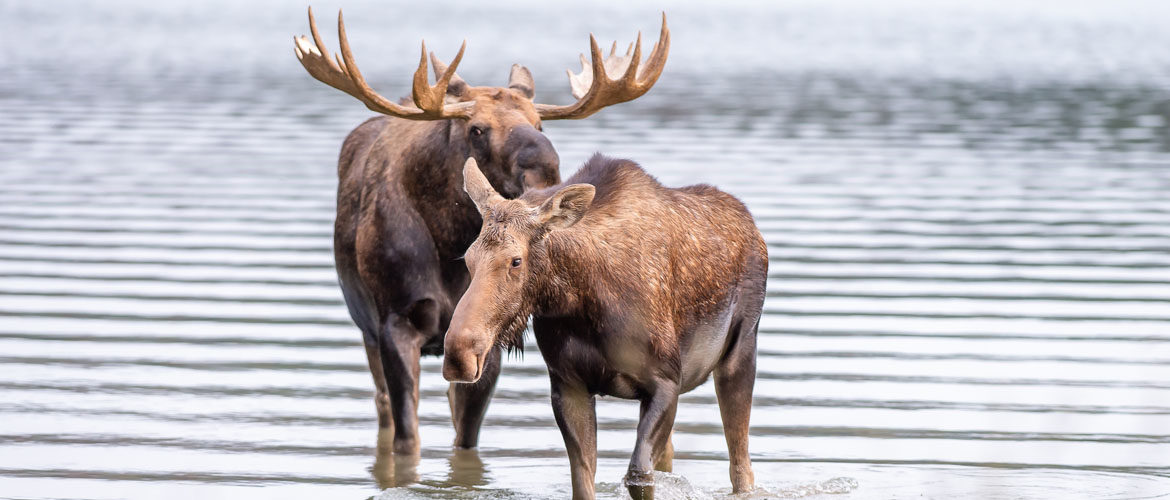
The Moose (Alces alces), is the largest and heaviest species of the deer family in North America. After the Bison, it is the largest terrestrial animal in North America, Siberia, and Europe. Their distribution is spread across several continents of the world from North America, Europe and Asia.
Most adult male Moose have distinctive presence with broad, palmated antlers. Typically inhabiting boreal forests and temperate broadleaf and mixed forests of the Northern Hemisphere in temperate to subarctic climates, their stature and size as well as their nasal vocalisations form an aura of mystic that demands attention should one be lucky enough to encounter a mature animal in the wild.
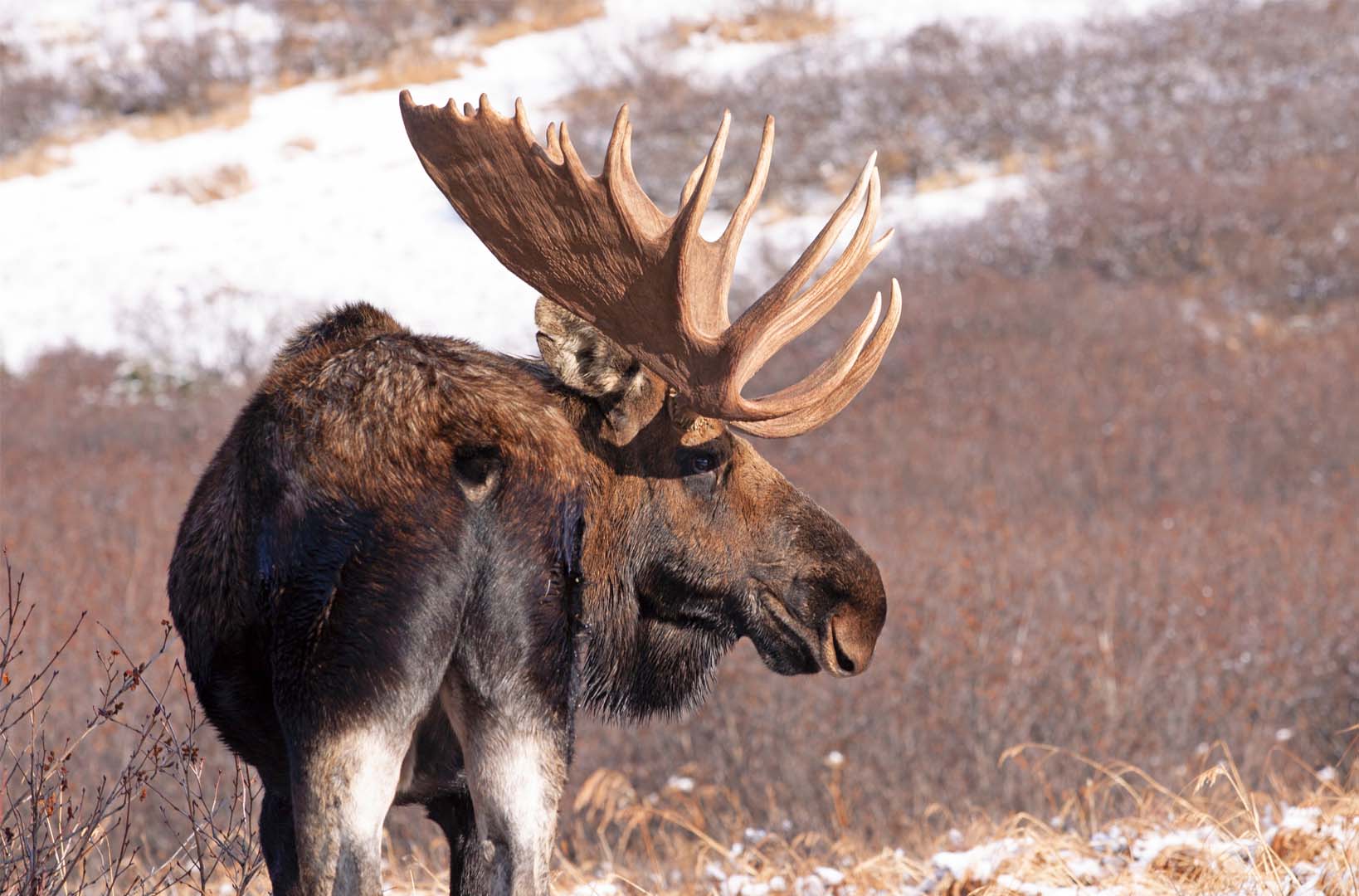
Alces alces is referred to as a “Moose” in North American English, but an “Elk” in British English(Oxford English Dictionary (2nd ed.). 1989 [1891]). As noted previously, the word “Elk” in English refers to a completely different species of deer, Cervus canadensis, also called the Wapiti.
According to the Oxford English Dictionary, the origin of the naming of the Moose species is “of obscure history The word “Elk” remained in usage because of English-speakers’ familiarity with the species in Continental Europe; however, without any living animals around to serve as a reference, the meaning became rather vague, and by the 17th century “Elk” had a meaning similar to “large deer”. Dictionaries of the 18th century simply described “Elk” as a deer that was “as large as a horse” (Bailey, Nathan (1731). A Universal Etymological English Dictionary Royal Exchange). As the Moose was obviously a strange deer to the colonists, they often adopted local names for both. In the earlier days of colonization, the Wapiti was often called a “Grey Moose” and the Moose was often called a “Black Moose”, but early accounts of the animals varied wildly, adding to the confusion.
For example, in 1736, Samuel Dale wrote to the Royal Society of Great Britain:
“The common light-Grey Moose, called by the Indians, Wampoose, and the large or Black-Moose, which is the beast whose horns I herewith present. As to the Grey Moose, I take it to be no larger than what Mr. John Clayton, in his account of the Virginia Quadrupeds, calls the Elke … was in all respects like those of our red-deer or stags, only larger … The Black Moose is (by all that have hitherto write of it) accounted a very large creature. … The stag, buck, or male of this kind has a palmed horn, not like that of our common or fallow-deer, but the palm is much longer, and more like that of the German Elke.”
It is generally accepted that moose of North America came from Siberia somewhere during the last glacial period, around 10,000 to 14,000 years ago. The Moose on average, stands 1.4–2.1 meters high at the shoulder, which is more than approximately 30 centimetres higher than the Elk. Males or “bulls” normally weigh from 380 to 700 kilos and females (or “cows”) typically weigh 200 to 490 kilos. This wide variation in weight and size attributing to climatic/distributions factors (Franzmann, A. W. (1981). Alces alces. Mammalian Species).
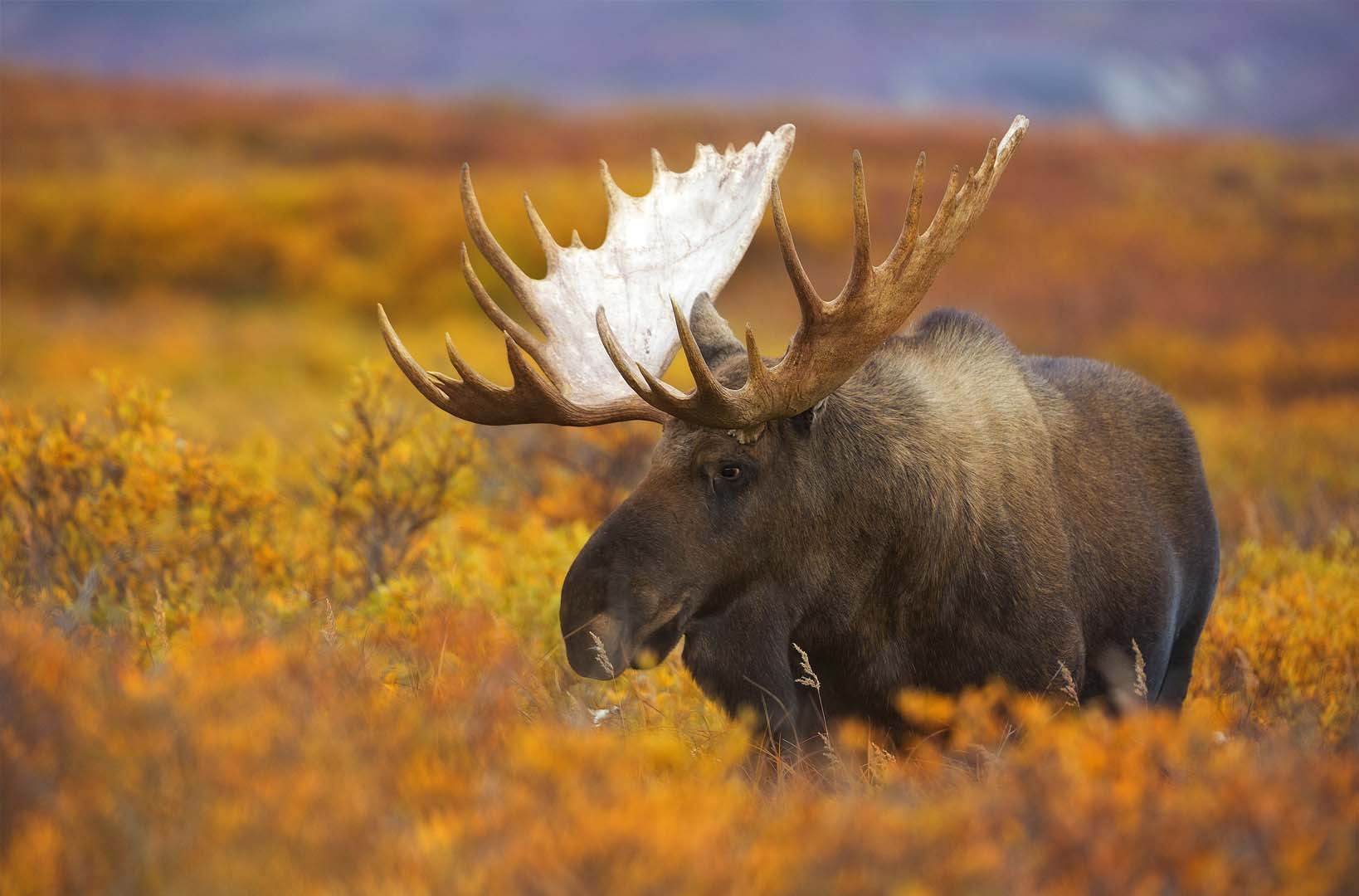
Length of the Moose is averaged at 2.4–3.1 meters, with the tail adding a further 5–12 centimetres, which is rather short given the size of the animal. The largest body size of all the distributed Moose is the Alaskan subspecies A. a. gigas, which can stand over 2.1 meters at the shoulder, has a span across the antlers of 1.8 meters (70 Inches) and averages 634.5 kilos for Bulls and 478 kilos in Cows (Long, Nancy; Savikko, Kurt (August 7, 2009). “Moose: Wildlife Notebook Series – Alaska Department of Fish and Game). Typically, however, although still large, the antlers of a mature bull can be expected to measure between 1.2 meters and 1.5 meters. Noting that in trophy terms they are referred to in Inches of the spread of the antlers and therefor average 47 Inches to 60 Inches.
The largest confirmed size for this species was a bull shot at the Yukon River in September 1897 that weighed 820 Kilos and measured 2.33 meters high at the shoulder. The Moose, as referred to previously as the “Black-Moose” was so named as the pelage of the animal ranges from jet black to chestnut and is of two layers; the top layer of long course guard hairs and a soft undercoat of finer hair, often of a slightly different colour. The guard hairs are hollow and filled with air for better insulation, which also helps them stay afloat when swimming, to which they are excellent at and readily take to the water. At which point they are able to entirely close their nostrils.
Within the genus Alces, there is one species being Alces alces. Four subspecies are in North America:
• Shiras’ Moose (A. a. shirasi)
• Alaskan Moose (A. a. giga)
• Western Moose (A. a. andersoni)
• Eastern Moose (A. a. Americana)
Although carried in both sexes, the dewlap is most visible in males, it appears as a fold of skin under the chin. Its exact use is unknown, but theories state that it might be used in mating, as a visual and olfactory signal, or as a dominance signal by males.
The male of the species carries antlers, of which are palmated as well as carrying points to the front and the rear of the outer edge of structure. It is worth noting that not all Bulls of the species develop antlers in this configuration. This can be due to a number of reasons however within the range of the moose in Europe, those in North display the palmated pattern of antlers, while the antlers of European moose in the southerly portion of its range are typically smaller without significant palmation. Moose are most active during the day, which is refered to as Diurnality and are generally solitary animals with the strongest bonds between mother and calf. Moose rarely gather in large groups although there may be several in close proximity during the mating season.
The mating season, referred to as the “Rut”, occurs in late September and into October. During the rut, mature bulls will cease feeding completely for a period of approximately two weeks; The males will cover expansive distances to seek several females to breed with. During this time both sexes will call to each other. Males produce heavy grunting sounds, while females produce wail-like long nasal call. Males will fiercely fight for access to females during this period as well as travel long distances in the course of the rut in search of receptive females. Female moose have an eight-month gestation period, usually bearing one calf, or twins if conditions are suitable, in May to June. Newborn moose have a fur with a reddish hue in contrast to the brown appearance of an adult.
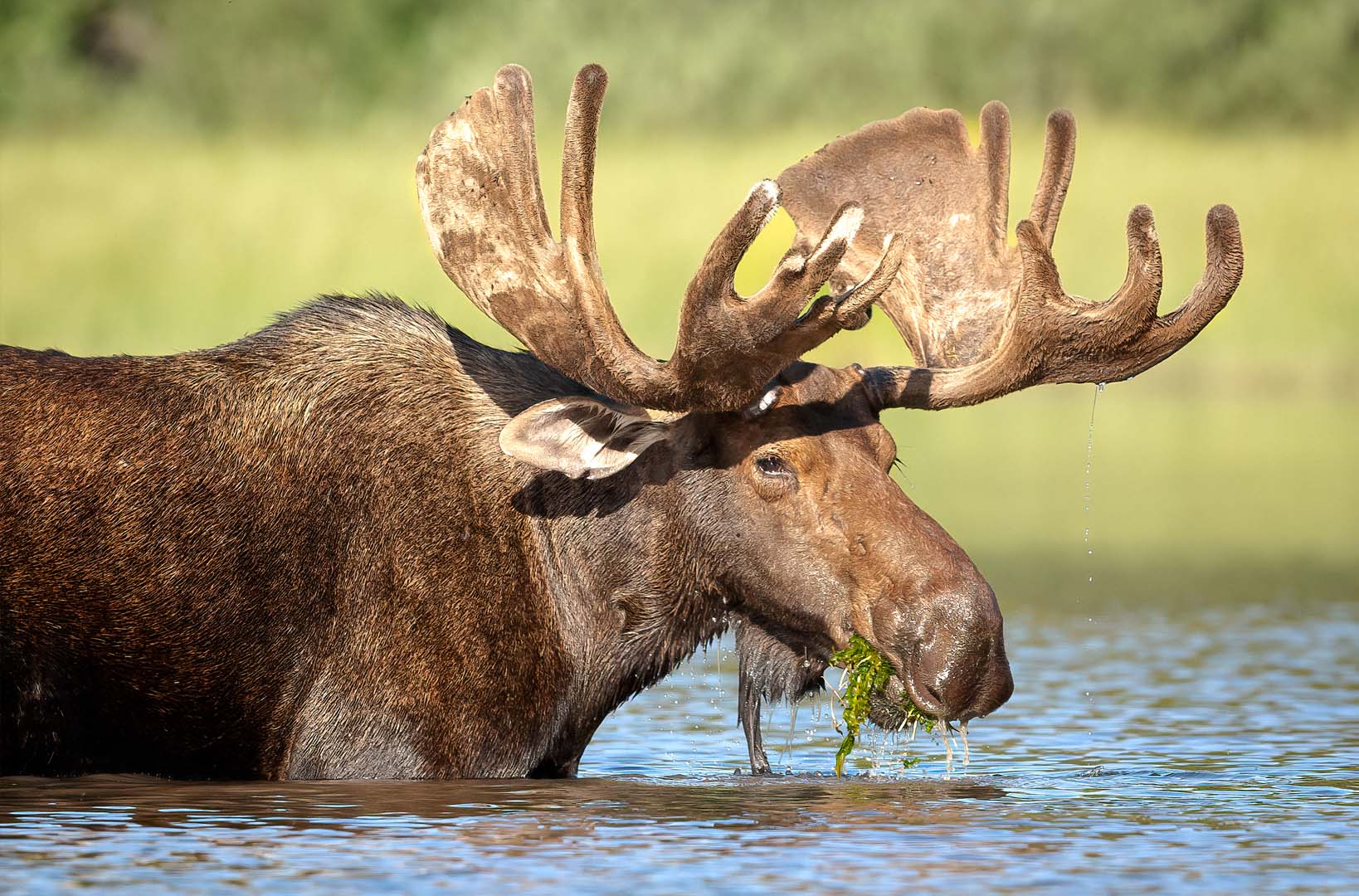
Where present, Siberian tigers (Panthera tigris altaica) regularly prey on adult Moose, as do Wolves (Canis lupus), especially females with calves. Brown bears (Ursus arctos) are also known to prey on moose of various sizes and are the only predator besides the wolf to prey on Moose both in Eurasia and North America. Grizzly and Black bears (Ursus arctos & Ursus americanus) as well as Cougars (Puma concolor) can be significant predators of Moose and Moose calves. Wolverine (Gulo gulo) are most likely to eat Moose as carrion but have killed moose, including adults, when the large ungulates are weakened by harsh winter conditions (Scrafford, Matthew A., and Mark S. Boyce. “Temporal patterns of wolverine (Gulo gulo luscus) foraging in the boreal forest.”). Most interesting of all predators is a reference to Killer whales (Orcinus orca) , according to reports, the Whale has been known to prey on Moose swimming between islands out of the North American Northwest Coast (Baird, Robert W.; Baird, Robin W. (August 31, 2006). Killer Whales of the World: Natural History and Conservation) . There is at least one recorded instance of a Moose preyed upon by a Greenland shark (“Moose-eating shark rescued in Newfoundland harbour”. CBC Newfoundland & Labrador. Canadian Broatcasting Corporation).
Moose with antlers not only serve in reproduction, defence and attack they also have been shown to increase a Moose’s’ ability to hear. A study of trophy antlers showed that males with antlers have more acute hearing than those without antlers; using a microphone, the study found that the palmate antler acts as a reflector, amplifying sound at the moose’s ear (Bubenik, George A.; Bubenik, Peter G. (2008). “Palmated antlers of moose may serve as a parabolic reflector of sounds”. European Journal of Wildlife Research). If a bull moose is castrated, either by accidental or chemical means, he will quickly shed his current set of antlers and then immediately begin to grow a new set of misshapen and deformed antlers that he will wear the rest of his life without ever shedding again. The distinctive-looking appendages, often referred to as “devil’s antlers”, are the source of several myths and legends among many groups of Inuit as well as several other tribes of indigenous peoples of North America (Geist, Valerius (1998) Deer of the World: Their Evolution, Behaviour, and Ecology).
The Moose population of temperate North America has been in decline since the 1990, although they remain stable in Arctic and subarctic regions. Populations did initially expanded greatly with improved habitat and protection (Robbins, Jim (October 14, 2013). “Moose Die-Off Alarms Scientists”). This decline has been largely attributed to predation, but also to the opening of roads and landscapes into the northern range of the Moose as well as allowing deer to become populous in areas where they were not previously common. This encroachment by deer on Moose habitat is thought to have brought Moose into contact with previously unfamiliar pathogens, including brain worm and liver fluke, and these parasites are believed to have contributed to the population decline of Moose.
In North America, the Moose range includes almost all of Canada (excluding the true arctic and Vancouver Island), most of Alaska, northern New England and upstate New York, the upper Rocky Mountains, northern Minnesota, northern Wisconsin, Michigan’s Upper Peninsula, and Isle Royale in Lake Superior. This massive range, containing diverse habitats, contains four of the six North American subspecies. In the West, moose populations extend well north into Canada (British Columbia and Alberta), and more isolated groups have been verified as far south as the mountains of Utah and Colorado and as far west as the Lake Wenatchee area of the Washington Cascades. The range also includes Wyoming, Montana, Idaho, and smaller areas of Washington and Oregon. Moose now inhabit southwards in the western Rocky Mountains, with initial sightings in Yellowstone National Park in 1868, and then to the northern slope of the Uinta Mountains in Utah in the first half of the twentieth century(Wolfe, Michael L.; Hersey, Kent R.; Stoner, David C. (2010). “A History of Moose Management in Utah”). This is the southernmost naturally established moose population in the United States. In 1978, breeding pairs were reintroduced in western Colorado, and the state’s moose population is now reported at more than 1,000 animals.
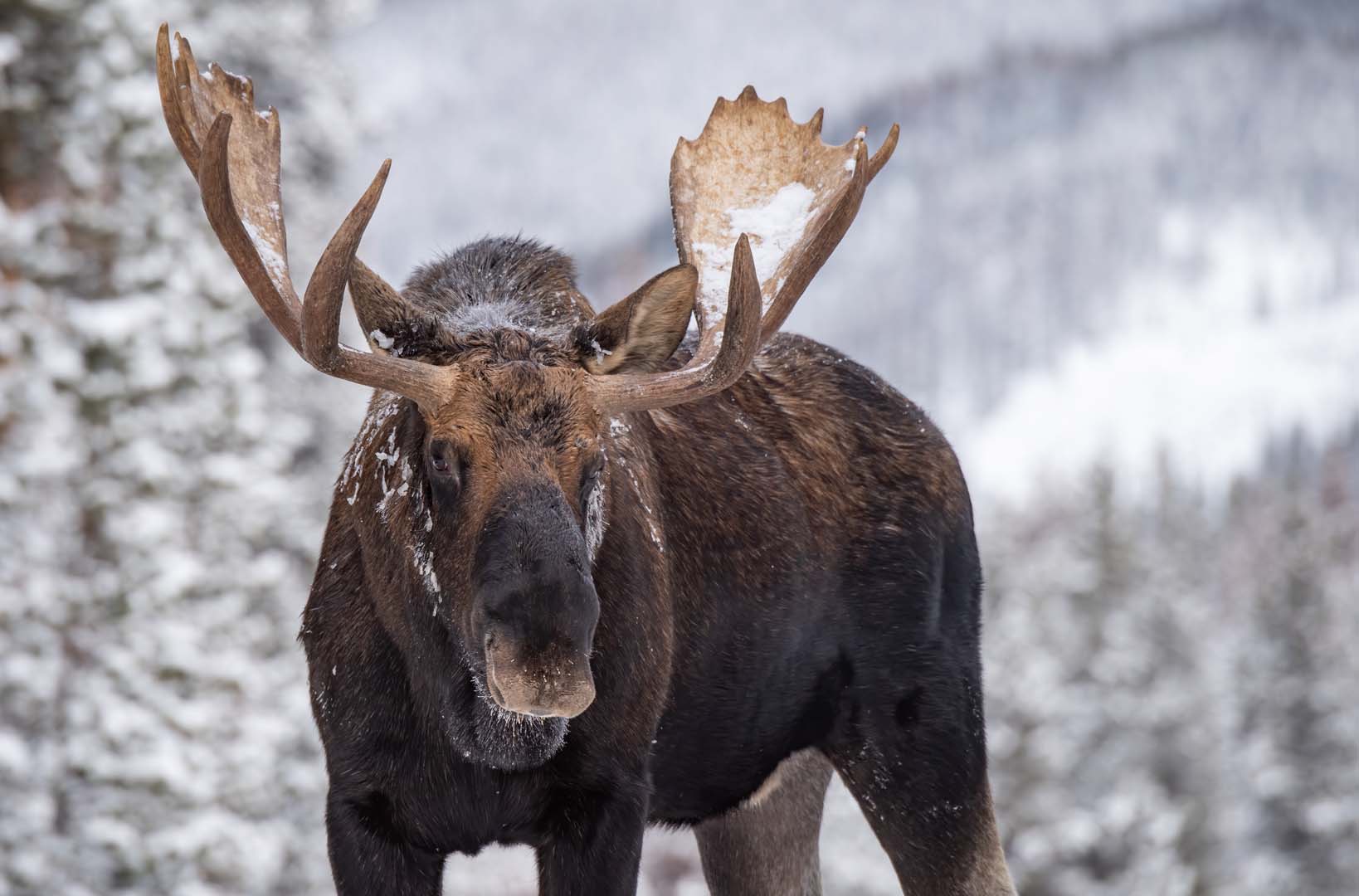
In North-eastern North America, the Eastern moose’s history is very well documented. Moose provided sustenance as well as a valuable resource where meat was often a staple in the diet of Native Americans going back several centuries. The Native Americans used Moose hides for leather and clothing, including moccasins and its meat processed into pemmican, a dried jerky used as a source of sustenance in winter or on long journeys prepared and preserved in fat.
The Moose has been extinct in much of the eastern U.S. for as long as 150 years, due to colonial era of overhunting and destruction of its habitat: Dutch, French, and British colonial sources all attest to its presence in the mid 17th century from Maine south to areas within a hundred miles of present-day Manhattan. However, by the 1870s, only a handful of moose existed in this entire region in very remote pockets. Although the Moose has in recent times been in decline, the Moose as a species can be a hearty animal given the opportunity as they were in Newfoundland. In 1878 and 1904, a release of moose in Newfoundland saw the animal prosper in the suitable habitat where they are now the dominant ungulate.
Moose require habitat with substantial edible plants such as pond grasses, young trees and shrubs. They also require cover from predators, and protection from extremely hot or cold weather. Moose travel among different habitats with the seasons in search of these requirements. Moose are cold-adapted mammals with thickened skin, dense, heat-retaining two layer pelage, and a low surface to volume ratio, which provides excellent cold. Moose survive hot weather by accessing shade or cooling wind, or by immersion in cool water. In hot weather, moose are often found wading or swimming in lakes or ponds.
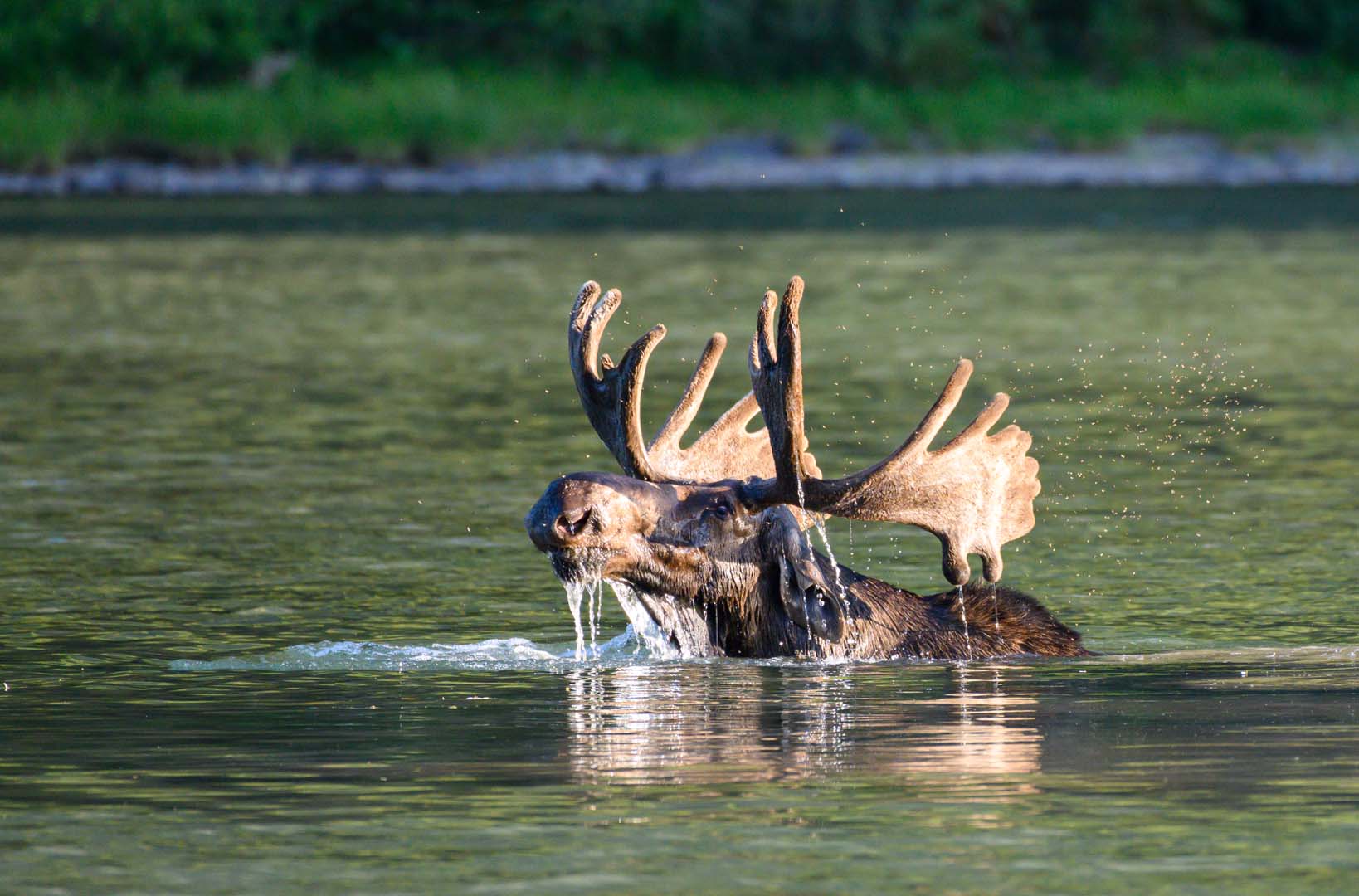
Moose avoid areas with little or no snow as this increases the risk of predation by wolves and avoid areas with deep snow, as this impairs mobility. Therefore, they appear to select habitat on the basis of trade-offs between risk of predation, food availability, and snow depth. The moose in predated upon by primarily wolves, and of course humans.
Although predated upon, the moose does have the ability to defend itself and while Moose are not usually aggressive towards humans, can be provoked or frightened to behave with aggression. They attack more people than bears and wolves combined, but usually with only minor consequences. In the Americas, Moose injure more people than any other wild mammal, and worldwide, only hippopotamuses injure more people. Moose are very limber animals with highly flexible joints and sharp, pointed hooves. They are capable of kicking with both front and back legs. Unlike other large, hooved mammals, such as horses, moose can kick in all directions including sideways.
In 1898, with the guiding hand of T. E Donne, the Canadian Government was approached in order to purchase a number of Moose. By October 1899, Mr A. McDonald of the Hudson Bay Company, of whom the Moose were to be obtained through, wrote to the New Zealand Government confirming that fourteen eight month old calves were ready for shipment. Despite lengthy delays, on the 5th of January 1900, the calves were loaded at Vancouver and commenced their journey. Wild weather dogged at the ship and ten died in the first week of travel. Arriving in Wellington, New Zealand via Sydney, Australia they were sent via boat to Greymouth and then rail to Hokitika where the semi tame animals were released. Two bulls and a cow would leave the release site never to be seen again while one cow remained in the vicinity and had to be shot fourteen years later after becoming a nuisance officially ending the story of the Hokitika Moose.
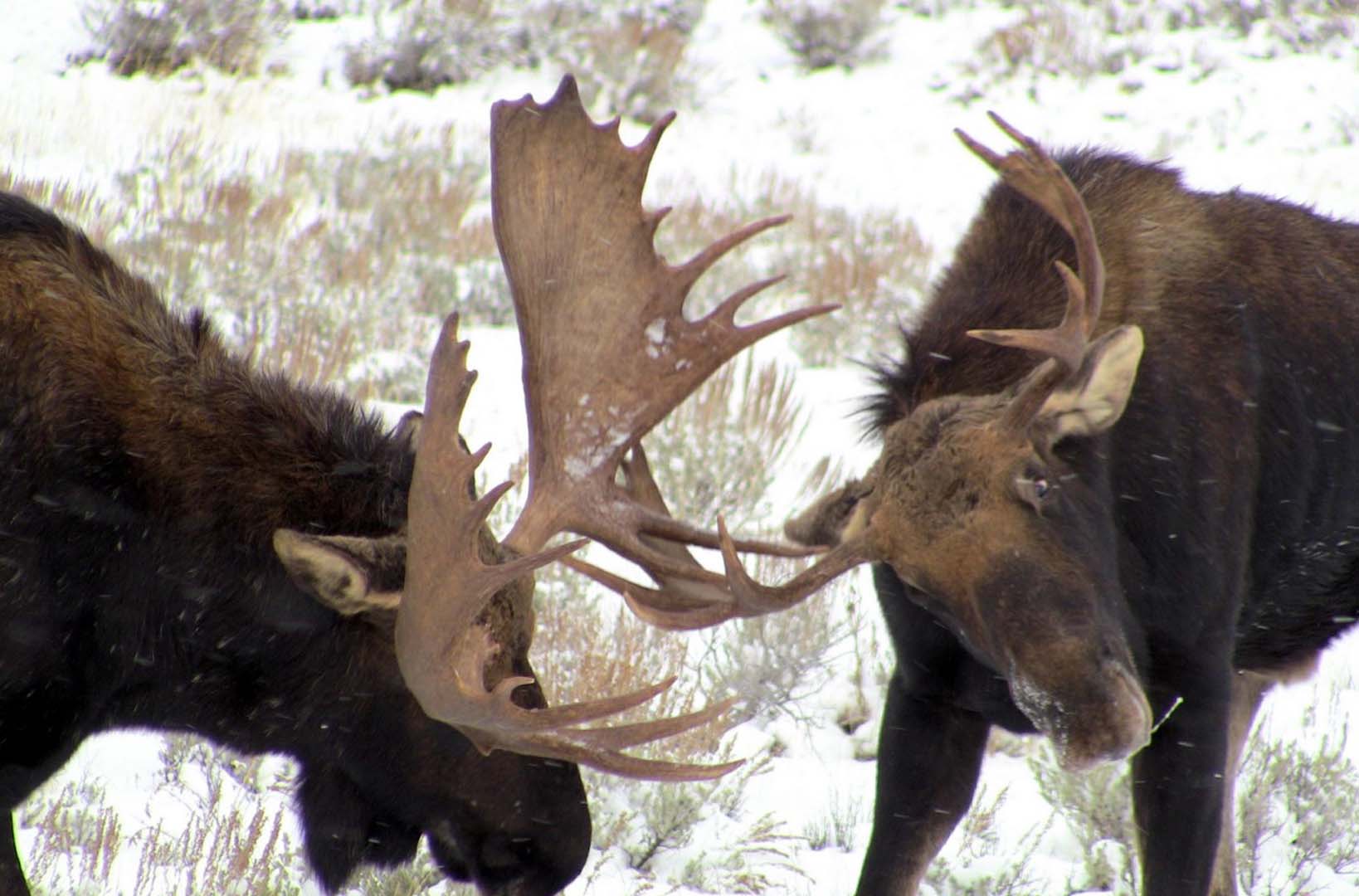
Again, in 1909, T.e Donne was called on to procure a number of Moose for a planned introduction into Fiordland. Unfortunately, much conjecture exists around the actual number and sex of the Moose imported and released, it is likely that this number will be lost to time forever. The precious cargo of Moose was sent on a roundabout trip of New Zealand and, as was the style at the time – released into the wild on April 6, 1910 at Supper Cove. Four Bulls and Six cows report to have been released, little written information exists from the time between the initial release and a report from F. Moorehouse that they had “thought” they had seen Moose in the Dusky Sound areas while conducting their 1921 Wapiti survey to the Department of Internal Affairs. Two years later, the first legally licenced Wapiti hunters, Les Murrell and Viv Donald spent five days chasing Moose in the area after securing the famous Wapiti of Viv’s, to no avail.
On March 10th, 1924, hunter Eddie Herrick, with his wife in tow made his first trip into the Moose “Block” of Fiordland. Despite ten days of hard hunting, his party was only able to turn up some sign, cast antlers and heard what they believe to be a cow calling.
Unlike places such as Newfoundland, the area in Fiordland appears to be less than ideal habitat, and Eddie Herrick called the fate of the herd early. Based on his assessments from his 1924 trip, the animals had already eaten their way through the Seaforth Valley. They were doomed, subsequent low numbers of sightings and kills have led to the presumption the population’s eventual failure. The last proven sighting of a Moose in New Zealand was in 1952(“Deer and deer farming – Introduction and impact of deer”. Te Ara – Encyclopedia of New Zealand) although Moose “sign” has been witnessed by Ken Sutherland in 1958, of course famous Moose believer Ray Tinsley in 1978, 1979, 1980, 1981 & 1982. Ken Tunstin saw cast antlers and rubs in 1972 and 1975 as well as footprint sighting by Bob Norton in 1980. Over the years stories surfaced, including unconformable photographs of, presumably, the Moose. A moose antler found in 1972 and some hair samples collected in 2002, reported from the Fiordland area had DNA testing done that concluded it was from a Moose. There has been extensive searching, and while game cameras failed to capture photographs, “evidence was seen of bedding spots, browsing, and antler marks” (“Hairs move NZ moose out of realm of Nessie”. NZ Herald. October 6, 2005).
Three Bull Moose and several cows have been officially recorded as shot in New Zealand since their introduction although many more are thought to have been taken by fisherman along the coast over time. Bruce Banwell writes “The quality of the antlers has been very poor and the novelty of shooting a Moose in New Zealand probably the reward for trying. According to some sources, the quality of the Moose in Saskatchewan, source of our animals, is of reasonable quality, hence the only remaining shortcoming – the environment. Red deer in this area were never renowned for producing antler”
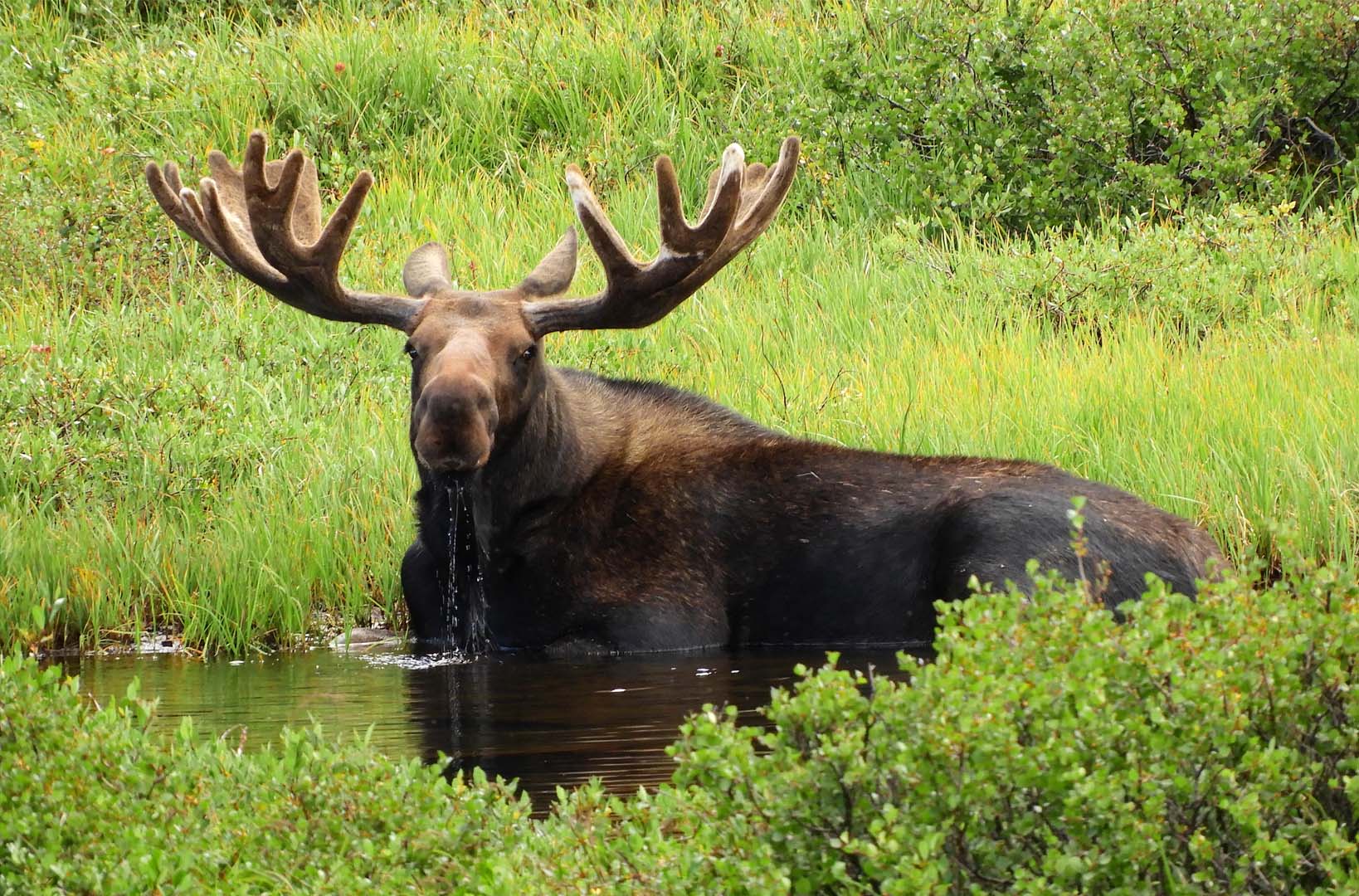
The three famous bulls were taken by licence in the “Moose block” of Fiordland by Eddie Herrick in 1929 and another in 1934, then finally, Percy Lyes in 1952. These hunters are no strangers to the history of deer in New Zealand and strong hunting ability.